How to Train Clients With a Chronic Illness (Step-by-Step Guide)
Understanding how to train clients with chronic illnesses can add a new dimension to your personal training business. However, it’s crucial to have the appropriate knowledge and tools to train these clients effectively and safely. Utilizing specific features of personal training software can aid in this process. Explore how to train clients with chronic illnesses and discover the tools you need in this detailed guide.
- Training clients with chronic illnesses requires careful planning and adjustments, as the exercise regimen should align with their abilities and needs without exacerbating their condition.
- Most clients with chronic illnesses will need a personalized, low-to-moderate intensity program that factors in their energy levels and potential symptoms.
- Implementing workout and assessment software can help secure your client’s safety and help them reach their fitness goals without unnecessary setbacks.
Venturing into training special populations, like clients with chronic illnesses, can provide personal trainers a meaningful way to expand their revenue streams.
To effectively train clients with chronic illnesses, not only should you have a deep understanding of their conditions, but also the necessary tools to make your training as beneficial as possible; that’s where personal training software comes into play. By leveraging the features of the best online personal training software, you can train clients with chronic illnesses in a manner that caters to their unique needs, not against them.

Experience the premier personal training software from Exercise.com by scheduling a demo today!
Understanding the Unique Challenges of Training Clients with Chronic Illness
Living with a chronic illness can present unique challenges when it comes to maintaining a healthy lifestyle. For individuals who are eager to incorporate regular exercise into their routine, it is essential to understand the specific considerations and adaptations required in order to train clients effectively. In this article, we will explore various strategies and techniques that can help trainers navigate this specialized area of fitness.
When training clients with chronic illness, it is crucial to have a comprehensive understanding of their condition, including its symptoms, limitations, and potential complications. Each chronic illness is unique, and it is important to approach training with sensitivity and individualization. Clients may experience fatigue, pain, or medication side effects, which can impact their ability to engage in physical activity. As a trainer, it is your responsibility to educate yourself about the specific chronic illnesses your clients are dealing with and how they may affect their exercise journey.
Furthermore, it is essential to communicate openly and regularly with clients about their symptoms and any changes in their condition. This will allow you to modify their training program as needed and ensure their safety and well-being. Additionally, it is important to establish realistic goals and expectations with clients who have chronic illness, taking into account their limitations and potential fluctuations in their health. By working closely with healthcare professionals and adapting training strategies accordingly, you can help clients with chronic illness improve their overall fitness and quality of life.
The Importance of Tailoring Exercise Programs for Clients with Chronic Illness
Clients with chronic illness require exercise programs that are tailored to their unique needs and limitations. When designing a program, it is essential to take into account factors such as their medical history, current health status, and specific goals. This individualized approach ensures that clients can participate in safe and effective exercises without exacerbating their symptoms or causing injury. Collaboration with healthcare professionals, such as doctors or physical therapists, can provide valuable insights and guidance when it comes to designing appropriate exercise programs.
Furthermore, it is important to consider the specific chronic illness that the client is dealing with. Different conditions may require different types of exercises or modifications to existing exercises. For example, clients with cardiovascular diseases may benefit from low-impact aerobic exercises, while those with arthritis may require exercises that focus on joint mobility and flexibility.
Identifying and Addressing Limitations and Medical Considerations
Chronic illnesses often come with various limitations and medical considerations that must be taken into account when designing a training regimen. Some clients may have mobility issues, restricted range of motion, or specific dietary needs. It is crucial to assess and address these limitations to ensure that exercise programs are both safe and beneficial. This may involve modifying certain exercises or incorporating adaptive equipment to accommodate the client’s unique circumstances.
In addition to physical limitations, it is also important to consider any psychological or emotional factors that may impact a client’s ability to engage in a training program. Chronic illnesses can often lead to feelings of frustration, anxiety, or depression, which may affect motivation and adherence to an exercise routine. Therefore, it is essential to provide a supportive and understanding environment, and to tailor the program to the client’s mental well-being as well.
Furthermore, it is crucial to stay updated on the latest research and medical advancements related to the specific chronic illness that a client may have. This knowledge can help inform the design of the training program and ensure that it aligns with current best practices. Regular communication with healthcare professionals, such as physicians or physical therapists, can provide valuable insights and guidance in addressing the unique needs and considerations of clients with chronic illnesses.
Building Trust and Establishing Clear Communication Channels with Clients
Developing a strong rapport with clients is integral to successful training, particularly when working with individuals with chronic illness. Building trust and establishing clear communication channels allows clients to share concerns, ask questions, and provide feedback. As a trainer, it is important to create a supportive and non-judgmental environment that encourages open dialogue. Regularly checking in with clients and adjusting training plans as needed is crucial to ensuring their comfort and progress.
One effective way to build trust with clients is by demonstrating empathy and understanding. Taking the time to listen actively and validate their experiences can help clients feel heard and valued. Additionally, being transparent and honest about your qualifications, expertise, and limitations can further establish trust and credibility.
Clear communication channels are essential for effective training. This includes not only verbal communication but also non-verbal cues and body language. It is important to be mindful of your tone, facial expressions, and gestures to ensure that your message is conveyed accurately and respectfully. Utilizing various communication tools such as email, phone calls, and video conferencing can also help maintain consistent and open lines of communication with clients.
Incorporating a Holistic Approach to Training Clients with Chronic Illness
When training clients with chronic illness, it is essential to adopt a holistic approach that considers not only their physical well-being but also their mental and emotional health. Chronic illness can take a significant toll on an individual’s overall well-being, and exercise can play a vital role in managing symptoms and improving quality of life. Incorporating stress management techniques and mindfulness exercises can help clients cope with the psychological challenges that often accompany chronic illness.
In addition to stress management and mindfulness exercises, nutrition also plays a crucial role in training clients with chronic illness. A well-balanced diet can help support the immune system, reduce inflammation, and provide the necessary nutrients for optimal health. Working with a registered dietitian can ensure that clients receive personalized nutrition guidance tailored to their specific needs and conditions.
Furthermore, it is important to create a supportive and inclusive environment for clients with chronic illness. This can be achieved by educating staff and trainers about various chronic conditions, their symptoms, and potential limitations. By fostering empathy and understanding, trainers can adapt exercises and modify routines to accommodate clients’ individual needs, ensuring a safe and effective training experience.
Adjusting Exercise Intensity and Duration to Accommodate Energy Levels
The energy levels of clients with chronic illness can vary greatly from day to day. It is crucial to allow for flexibility in training, adapting the exercise intensity and duration according to how the client feels on any given day. This may involve incorporating rest periods, modifying the number of repetitions or sets, or adjusting the overall workout duration. Creating a training plan that is responsive to the client’s energy levels is fundamental to preventing overexertion or exacerbation of symptoms.
Furthermore, it is important to regularly communicate with the client to assess their energy levels and any changes in their condition. This ongoing dialogue allows for adjustments to be made to the exercise program as needed, ensuring that it remains appropriate and safe for the client’s current health status.
In addition to adjusting exercise intensity and duration, it is also beneficial to incorporate a variety of exercise modalities into the training plan. This can help prevent boredom and maintain motivation, while also providing options for different energy levels. For example, on days when the client is feeling low on energy, low-impact exercises such as yoga or swimming may be more suitable, while on days with higher energy levels, more intense activities like weightlifting or cardio workouts can be included.
Designing Safe and Effective Warm-Up and Cool-Down Routines
Regardless of the client’s medical condition, it is essential to prioritize warm-up and cool-down routines. These routines help prepare the body for exercise and facilitate proper recovery afterward. For clients with chronic illness, warm-up exercises should focus on gentle movements that increase blood flow and promote joint mobility. Cool-down routines should incorporate stretching and relaxation techniques to aid in reducing muscle soreness and promoting overall well-being.
Additionally, it is important to consider the specific needs and limitations of each client when designing warm-up and cool-down routines. For clients with cardiovascular conditions, warm-up exercises should be low-impact and gradually increase in intensity to avoid putting excessive strain on the heart. Cool-down routines for these clients should include light aerobic exercises and deep breathing exercises to help lower heart rate and promote relaxation.
Utilizing Adaptive Equipment and Modifications for Client Comfort and Safety
Adaptive equipment and modifications can play a pivotal role in ensuring client comfort and safety during exercise sessions. Depending on the client’s specific needs, this may involve using assistive devices, such as walkers or canes, to aid in mobility or incorporating stability tools to enhance balance. Modification of exercises, such as using resistance bands instead of weights, can also be beneficial in reducing joint stress and increasing exercise accessibility.
In addition to assistive devices and exercise modifications, it is important to consider the use of proper padding and support to further enhance client comfort and safety. This can include using cushioned mats or pillows to provide extra support for clients with limited mobility or sensitive joints. Additionally, utilizing adjustable equipment, such as adjustable benches or chairs, can help accommodate clients of different heights or physical abilities. By incorporating these additional measures, trainers and caregivers can create a more inclusive and comfortable exercise environment for their clients.
Implementing Progressive Overload Strategies in a Controlled Manner
Progressive overload is a fundamental principle in training, allowing clients to gradually increase the difficulty or intensity of their exercises over time. However, when working with clients with chronic illness, it is crucial to implement these strategies in a controlled manner. This may involve smaller increments in intensity or more frequent breaks during workouts to prevent excessive fatigue or strain on the body. Tracking progress and adjusting the training plan accordingly can aid in ensuring that clients are continually challenged and progressing safely.
Monitoring Vital Signs and Recognizing Warning Signs during Training Sessions
During training sessions, it is crucial to closely monitor the client’s vital signs, such as heart rate and blood pressure. These measurements can provide valuable insights into the client’s exertion level and help identify any signs of overexertion or distress. Additionally, being aware of warning signs specific to the client’s condition, such as shortness of breath or chest pain, enables trainers to take immediate action when necessary. Regularly communicating with clients about how they are feeling during workouts is essential to ensuring their safety and well-being.
Educating Clients on Self-Care Strategies for Managing Chronic Illness while Training
Empowering clients with knowledge on self-care strategies is essential to their success in managing their chronic illness while engaging in regular exercise. Educate clients about the importance of proper nutrition, adequate sleep, stress management, and consistent medication management. Encourage mindfulness and self-awareness techniques to help clients recognize and manage their symptoms effectively. Providing educational resources and ongoing support helps clients take ownership of their health journey.
Promoting Lifestyle Changes to Support Overall Health and Fitness Goals
Training clients with chronic illness involves not only focusing on exercise but also addressing lifestyle factors that can impact their overall health and fitness goals. Encourage clients to make positive changes in their daily routines, such as adopting a balanced diet, prioritizing sufficient sleep, and reducing stress. These lifestyle modifications can complement the training program and contribute to a holistic approach to wellness.
Collaborating with Healthcare Professionals to Ensure a Comprehensive Approach
A collaborative approach involving healthcare professionals is crucial when training clients with chronic illness. Engage with the client’s healthcare team to gain a comprehensive understanding of their condition, receive medical guidance, and ensure that the training program aligns with their treatment plan. This collaboration encourages a seamless integration of fitness and healthcare, leading to improved outcomes for the client.
Celebrating Small Victories and Encouraging Long-Term Commitment to Fitness Journey
For clients with chronic illness, every achievement, no matter how small, should be acknowledged and celebrated. Acknowledging these victories helps build confidence and encourages long-term commitment to their fitness journey. Encourage clients to set realistic goals and celebrate milestones along the way. Positive reinforcement and ongoing motivation play a crucial role in maintaining their dedication and overall well-being.In conclusion, training clients with chronic illness requires a comprehensive understanding of their condition, individualized exercise programming, and a supportive approach that addresses their unique challenges. By adopting a holistic approach and considering their limitations, trainers can empower these clients to reach their fitness goals while managing their chronic condition effectively. Through open communication, adaptations, and collaboration with healthcare professionals, trainers can create a safe and supportive environment that fosters overall well-being and long-term success.
How can we help clients with chronic illness?
Helping clients with chronic illness involves creating a personalized fitness plan that takes into account their specific health condition, limitations, and goals. It’s essential to communicate closely with the client and their healthcare provider to ensure the exercise regimen aligns with their medical treatment plan. Regular reassessments are also crucial as their condition and abilities may change over time. Providing emotional support and encouragement can also make a significant difference in these clients’ motivation and persistence.
What is the best exercise for chronic illness?
The best exercise for a person with chronic illness varies based on the specific disease, the individual’s physical abilities, and their personal preferences. However, low-impact activities like walking, swimming, cycling, and yoga are often beneficial and can usually be adapted to accommodate various physical limitations. Before starting any new exercise regimen, individuals with chronic illnesses should consult their healthcare provider.
How is a person with a chronic disease best managed?
The management of a person with a chronic disease requires a comprehensive and individualized approach that typically includes medication, diet, stress management, and regular exercise. In terms of fitness, it’s critical to create a safe and effective exercise plan that considers the person’s specific health concerns and fitness level. Regular monitoring and adjustments are needed to ensure the client remains safe and continues progressing towards their fitness goals.
What are low-impact exercises for chronic illness?
Low-impact exercises are ideal for people with chronic illnesses because they are less stressful on the body and can be easily adapted to individual needs. Examples include walking, swimming, cycling, chair exercises, light strength training, stretching, yoga, and Pilates.
What is chronic exercise training?
Chronic exercise training refers to the long-term, consistent engagement in exercise or physical activity. It’s often used to manage and alleviate symptoms of chronic diseases and improve overall health. The specific routines and intensities can vary based on the individual’s health status and goals, but it generally involves a combination of aerobic, strength, and flexibility exercises. Regular exercise has been shown to provide numerous benefits for individuals with chronic illnesses, including improved physical function, reduced symptoms, better mood, and enhanced quality of life.
Use the Best Personal Training Software to Offer a Stellar Client Experience
Training clients with chronic conditions requires a comprehensive and tailored approach. See how Exercise.com can help.

To learn more about how Exercise.com can help you run your fitness business, book a demo now!
Creating Training Plans for Clients with a Chronic Illness
Here’s how you can help your clients accomplish their training goals by using workout plan creator software to create workout plans, run fitness challenges, offer online workout groups, message clients, and more, all from your very own custom branded fitness apps.
Exercise.com stands out as an all-in-one fitness business management software with comprehensive workout plan sales capabilities. The robust member management, billing & invoicing, and unique fitness assessment tools offer a one-stop solution for fitness business needs. Here’s just some of what you can do with the Exercise.com platform:
Engage with clients via automations.
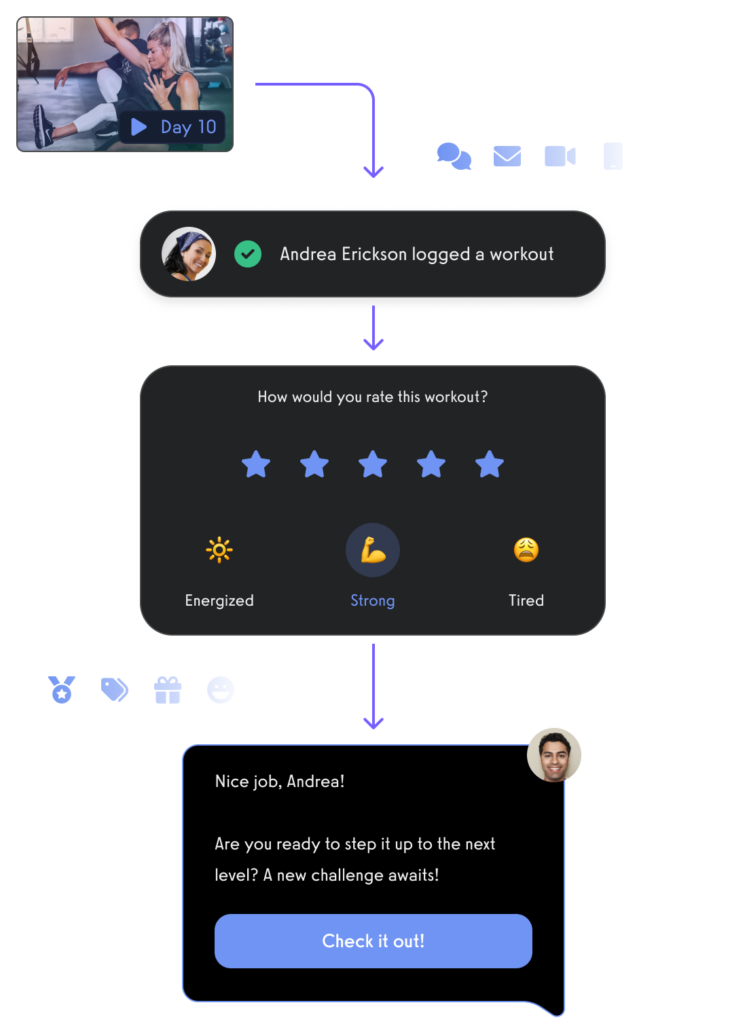
Manage leads with a fitness CRM.

Create and send fitness assessments with ease.
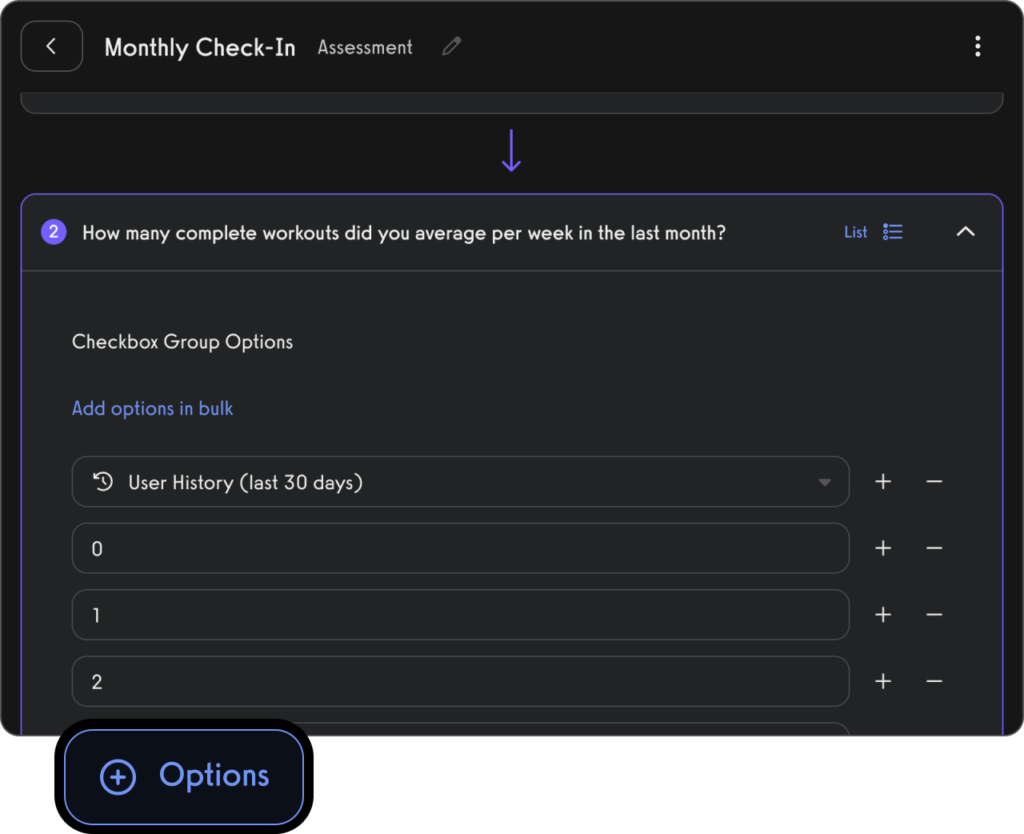
Use fitness habit tracking to inspire and motivate personal training clients (in-person and remote).

Use fitness progress photos to engage with clients.
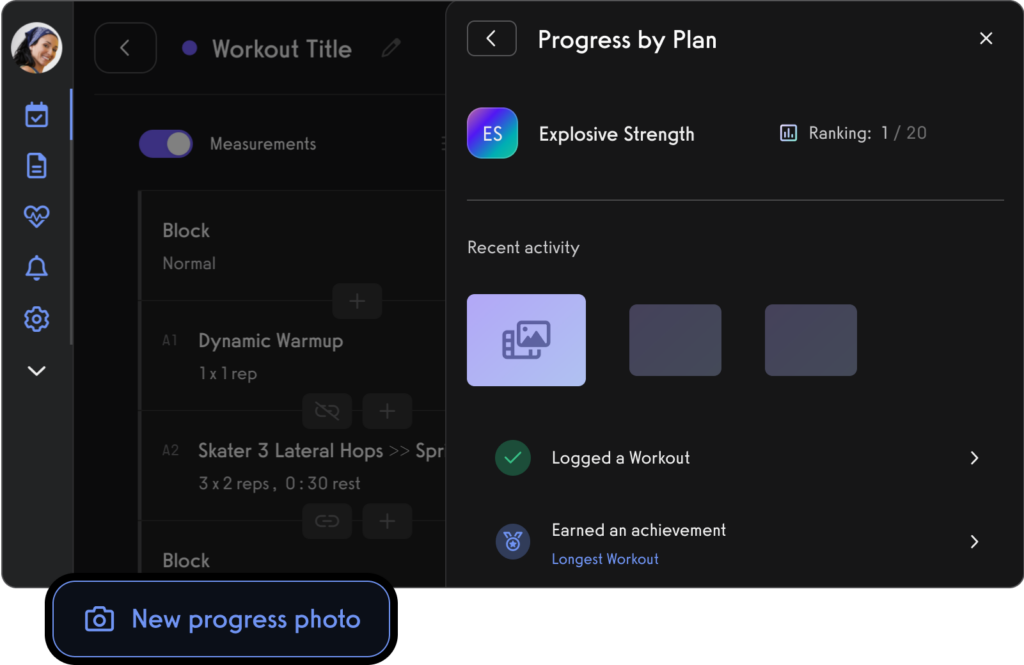
Use fitness leaderboards to track performance and inspire healthy competition.
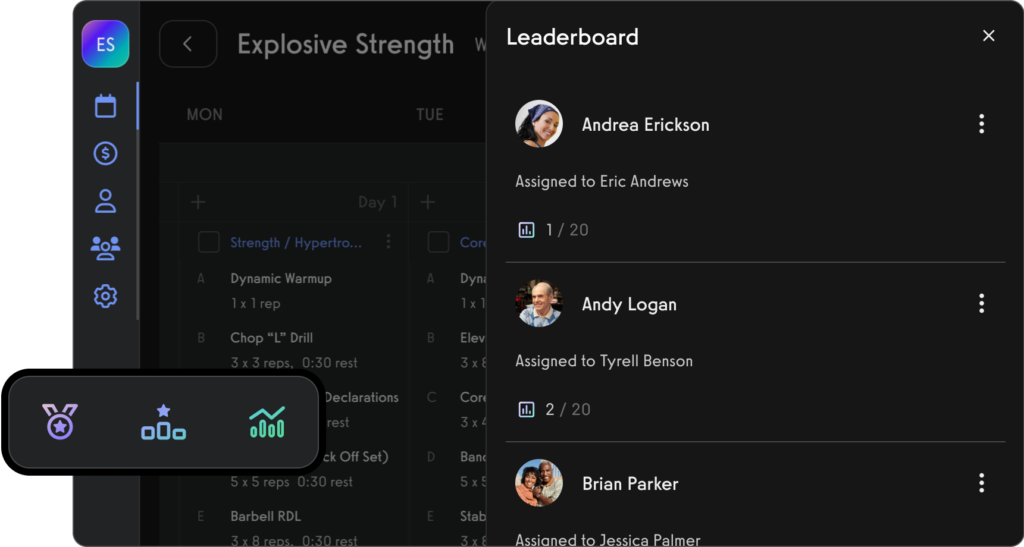
Use the exercise demonstration video library or create your own custom exercise demonstration videos.

Create workout plans for parents and dependents, teams and more.

Manage personal training clients with ease.

Book appointments for clients (Read More: Best Gym Booking Software)

Create classes and fitness groups

Manage fitness challenges (Read More: 100+ Fitness Challenge Ideas)
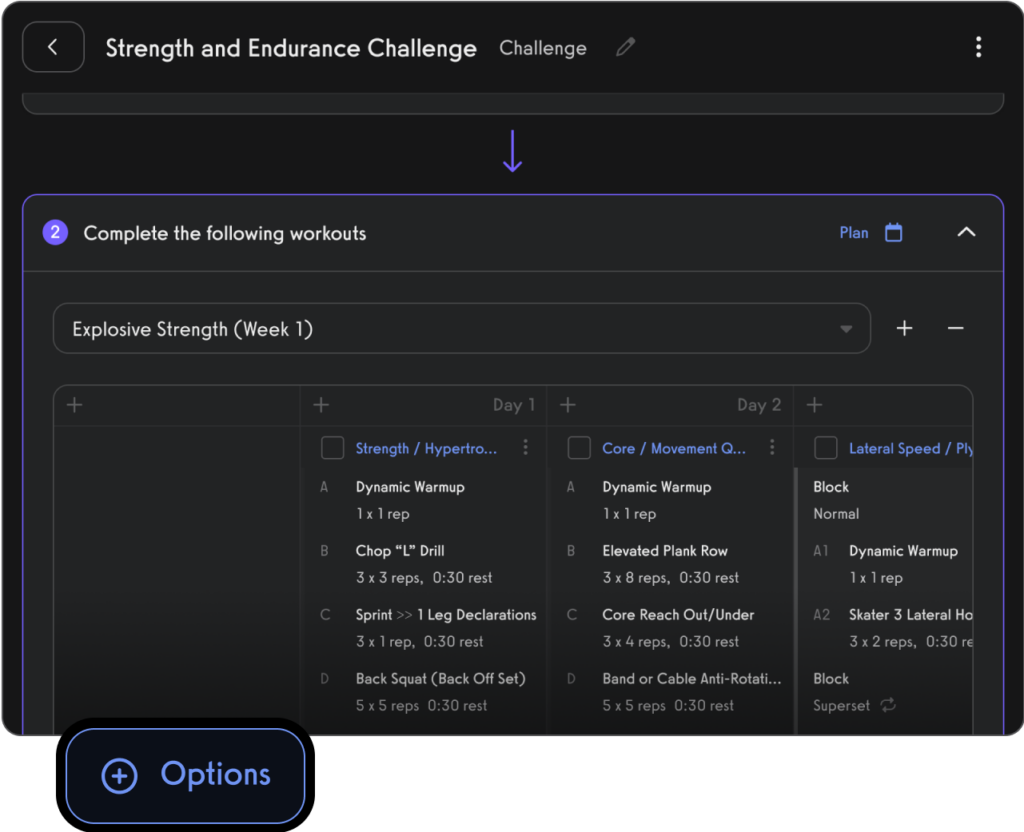
Process payments for open gym, classes, and personal training.

Communicate with gym members, athletes, team members, personal training clients, class members, parents, and dependents via SMS, email, and in-app push notification.
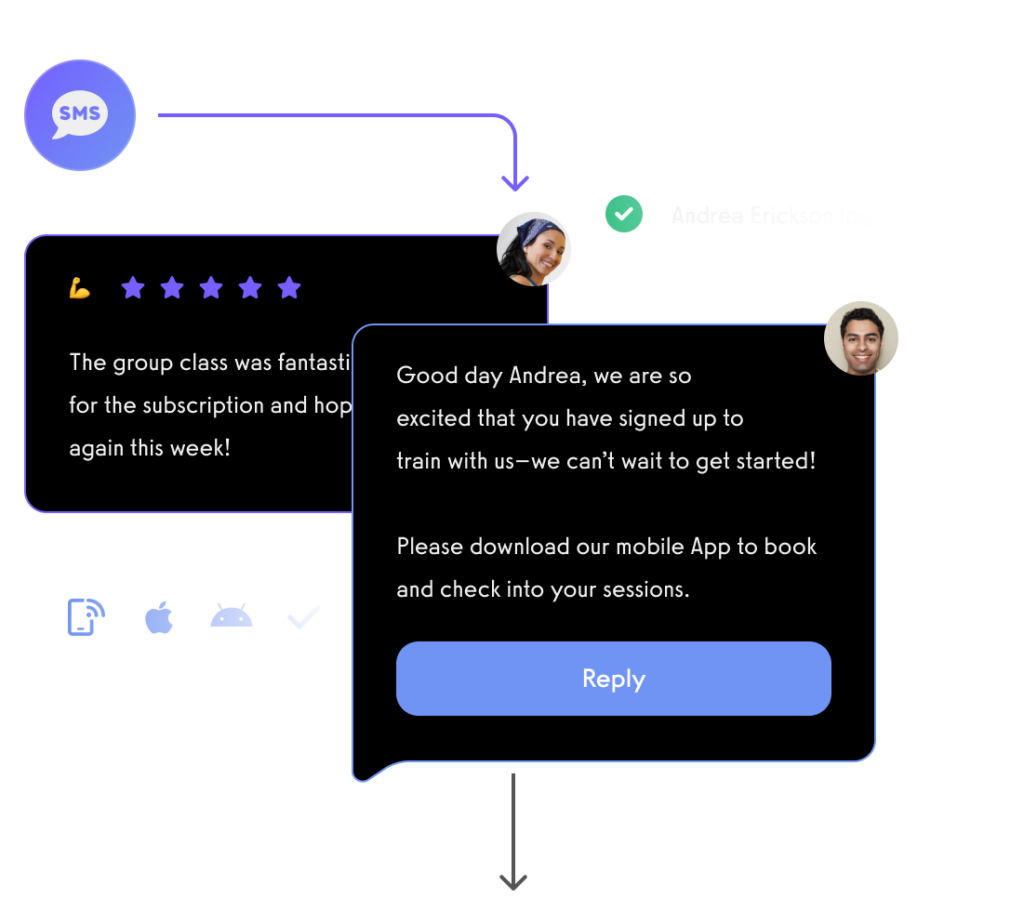
View performance over time, track personal records, and other fitness stats with performance reporting dashboards.
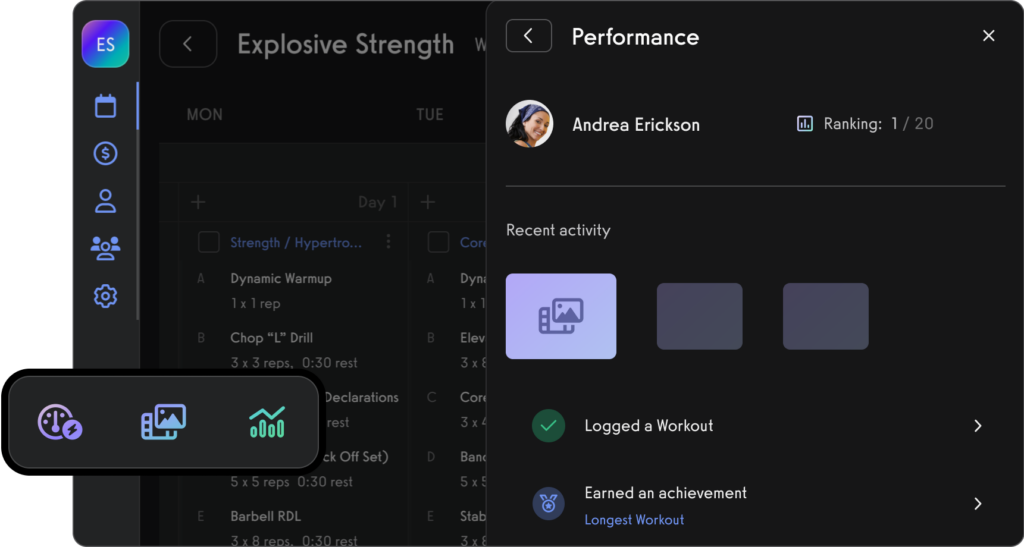
And of course, view all of your fitness business reports easily too.

All from your custom-branded fitness apps (Read More: Best Gym Mobile Fitness Apps Software)


Want to learn how your fitness business can take it to the next level? Get a demo now!









